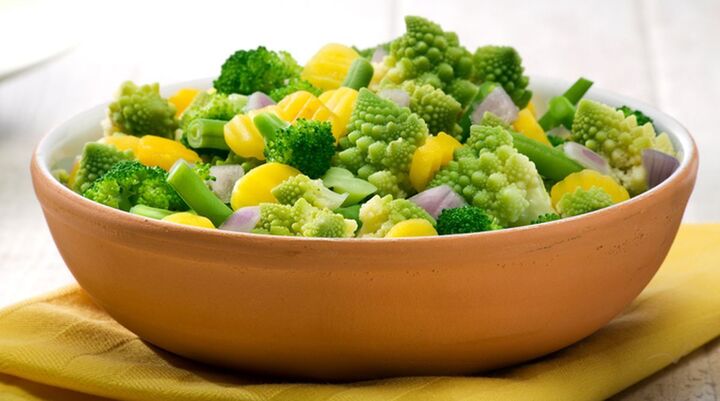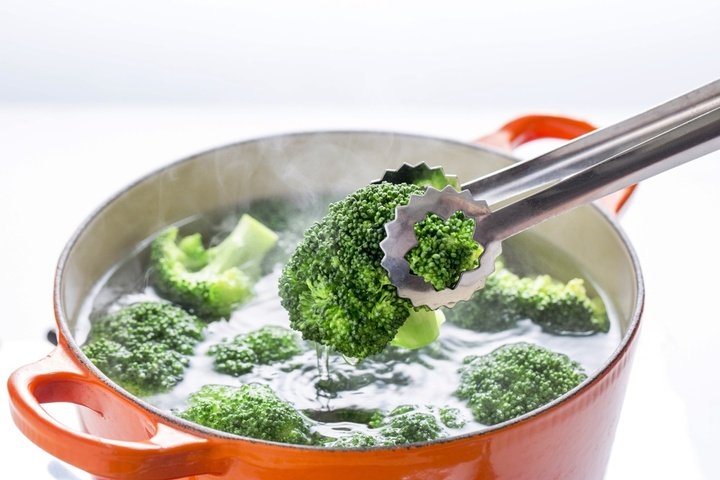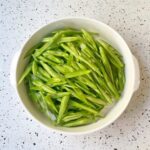Vegetable oil is primarily used for frying, stir-frying, and marinating grilled dishes. Boiled dishes, especially boiled vegetables, emphasize simplicity, which is considered a necessity to stay away from oily foods. Therefore, the concept of adding oil when boiling vegetables is seemingly foreign to Vietnamese cuisine, and those who do so may even be considered clumsy or careless.
However, with the intersection of various cuisines and the open-mindedness in cooking, many rules are being broken. Vietnamese cooks are embracing and creating new cooking methods, and adding oil when boiling vegetables is no longer considered odd or unusual.
What are the benefits of adding oil when boiling vegetables and fruits?
Adding vegetable oil when boiling vegetables and fruits brings many advantages, but you must accept that the boiling water will have an oily film.
Retaining the color of vegetables and fruits
One of the most significant benefits of adding vegetable oil to the boiling water is preserving the bright and natural color of the produce. Vegetables and fruits tend to lose their natural color when exposed to high temperatures, especially green vegetables like bok choy, broccoli, green beans, and spinach. The vibrant green turns into a dull green or yellowish color, making the dish less appealing.
Adding a small amount of oil creates a thin protective layer on the surface of the produce, reducing oxidation when exposed to air. This helps retain the bright color of the vegetables, making the dish more attractive and appealing.

One of the greatest benefits of adding vegetable oil to the boiling water is preserving the bright and natural color of the produce. (Image: The Statasman)
Enhancing the flavor of vegetables and fruits
The oil added to the boiling water not only acts as a color preservative but also enhances the flavor of the produce. Many vegetables and fruits have a bland taste, and boiling them can result in a significant loss of their natural flavor due to being submerged in water. By adding a small amount of oil, you can considerably improve the taste of the vegetables and fruits.
The oil coats the surface of the produce, retaining their natural sweetness and adding a subtle buttery flavor. Carrots, broccoli, and green beans boiled with a touch of oil become smoother and more flavorful, avoiding dryness or toughness.
Preventing vegetables from sticking together
Vegetables with soft or thin surfaces, such as water spinach, bok choy, and spinach, tend to stick together after boiling, reducing their aesthetic appeal and causing inconvenience during consumption. The stuck-together vegetables also trap heat, causing discoloration and a loss of flavor.
Adding oil when boiling creates a thin film between the leaves or stalks of the vegetables, preventing them from sticking firmly together.
Increasing the absorption of nutrients
Many vegetables and fruits contain vitamins that are fat-soluble, such as vitamins A, D, E, and K. Adding oil when boiling helps the body absorb these vitamins more efficiently.
For example, carrots are rich in beta-carotene, a precursor to vitamin A and a fat-soluble substance. Combining it with oil aids in the absorption of this nutrient.
Reducing water absorption by vegetables and fruits
During the boiling process, vegetables and fruits absorb water and become softer, losing their natural crispness and sweetness. Adding oil can create a protective layer on the surface, preventing them from absorbing too much water and helping retain their crispness and sweetness after boiling.
This is especially important for salads or mixed vegetable dishes, where maintaining crispness is crucial for a more appealing and palatable dish.
Notes on boiling vegetables and fruits with oil

Add the oil once the water starts boiling, before adding the vegetables, to ensure even distribution and create a protective layer. (Image: Recipes.net)
To maximize the benefits of adding oil when boiling vegetables and fruits, keep the following in mind:
– Use a moderate amount of oil: You only need about 1-2 teaspoons of oil per pot of boiling water. Using too much can make the dish overly greasy and take away from its natural freshness.
– Choose the right type of oil: Olive oil or canola oil are good choices as they contain antioxidants, have a high smoke point, and help maintain the safety and quality of the dish when cooking at high temperatures.
– Bring the water to a boil before adding the produce: Wait until the water is boiling to add the vegetables or fruits, preserving their crispness and minimizing water absorption.
– Add the oil once the water starts boiling: This ensures that the oil is evenly distributed in the water, creating a protective layer for the produce.
According to VTCnews
The Easiest Way to Remove 502 Glue in a Flash
Introducing the Ultimate Guide to Removing Super Glue from Your Skin: A Sticky Situation Solved!
We’ve all been there: that moment when you realize super glue has accidentally bonded to your skin. It’s a sticky, frustrating situation that can leave you feeling helpless. But fear not! This comprehensive guide will equip you with the knowledge and tools to safely and effectively remove super glue from your hands or any other body part. With our expert tips and tricks, you’ll be able to bid farewell to that unwanted adhesive in no time!




































